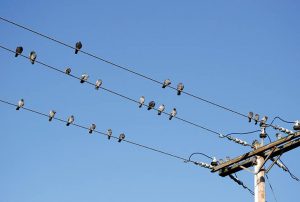
Everyone knows we should never, ever touch a power line. But have you ever wondered why birds don’t get shocked as they dance a high-wire act on power lines?
Their ability to perch high above on high-voltage wire has everything to do with the connections they are making, or not making.
Electricity flows by the movement of electrons through conductors. People are very good conductors. Birds usually are not.
A bird sitting on a wire does not get electrocuted because there is no voltage difference in a single wire. For electrons to move, there must be what scientists call a difference in electrical potential. Electricity flowing through a single power line at 35,000 volts will continue along the path of least resistance and bypass birds because there’s no difference in electrical potential.
Birds also don’t get electrocuted because they are not good conductors of electricity. Their cells and tissues do not offer electrons an easier route than the copper wire inside the power lines they’re sitting on. As a result, the electricity bypasses the birds and keeps flowing along the wire instead.
However, if the bird touches the ground while sitting on the wire or flaps its wings and touches another electric wire with a different voltage, then it would get electrocuted. This is because its body became a path for the electricity to reach either the ground (no voltage) or a place with a different voltage (another wire with a different voltage).
The same holds true for humans.
If we touch an energized power line, the electrons have nowhere to go to get to the ground except through us. And that’s never, ever a good outcome.
So please, never touch a downed power line. Do not get out of your car if you hit a power line or power pole. Instead, report the situation immediately to authorities and your electric company.



